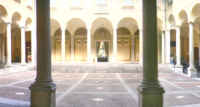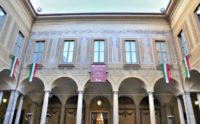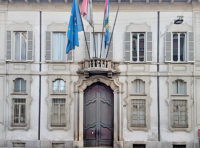35 Corso Monforte
Milano
Lombardia
20122
IT
The oldest part, named after a family that owned it, was built in the 15th century. However, it has been considerably altered during the course of the centuries that have followed Inside hang paintings by Tiepolo and other artists. It is now seat of the Provincial Council of Milan.
0.26 km
St. Maria Della Passione’s Church rises between Via Conservatorio and Via V. Beilini. It was built by oder of Domenico Birago, Prothonotary Apostolical, appointed by Sisto IV as...
0.35 km
This large and majestic building was enlarged in the Neoclassical style by Simone Cantoni at the end of the 18th century. The façade has three orders, or rows, of windows that h...
0.38 km
This linear and unadorned façade makes it a typical example of 15th century Milanese architecture. There is a wrought iron balcony on the exterior above the main door which is d...
0.42 km
The basilica ol San Babila, now squashed in by modern buildings, was, perhaps, built at the end of the Xlth century on the site of another, but older, church founded by St. Lore...
0.46 km
Styles called “floreale” and “Liberty” were fashionable at the beginning of 20th century. They were typified by heavy ornamentation of figures, columns, ...
0.47 km
Here is another example, like Palazzo Serbelloni, of the grandiose Neoclassical style of architecture that was in vogue during the Napoleonic Era. It is the work of the early 18...
0.51 km
At No. 11 Corso Venezia we can see the building which was once the “Seminario Maggiore” founded by St. Carlo in 1561, this buildings built on the site of the ancient “Umil...
0.51 km
This 17th century mansion is the dwelling of the famous orchestra conductor s family. On the outside is a superb wrought iron railing on the central balcony The larghe front doo...
0.52 km
Fabio Mangone, the master builder of the Duomo and favorite arch tect of Cardinal Federico Borromeo began to construct this austere edifice in 1620. It was intended to house the...
0.53 km
This 15th cent, church has been poorly remodeled more than once since its construction, its façade was restored in Lombard style. The interior has three aisles, 12 side chapels,...
0.59 km
Illustrations and paintings recall the historical events of the city from the 17th to the early years of the 20th century. ...
0.59 km
Over one million insects, twenty-four thousand birds, seventeen thousand minerals, one hundred thousand fossils and a large specialized library: this is only part of what can be...
0.6 km
The present day basilica of St. Carlo was built on the site of the old church and convent ol the Servants of Mary. When preparations for Ferdinando I of Austria’s entrance into ...
0.6 km
The correct name would be Palazzo Morando Attendolo Bolognim. It now contains a municipal museum collection. The Barocchetto style facade has been partly remodeled. The staircas...
0.63 km
This building is commonly called the ’’Royal Villa” but it was built by the Viennese architecht Leopold Poliak in 1790 as the home of Count Lodovico Barbiano di Belgioioso...
0.68 km
Via Monte Napoleone is synonymous with opulence, elegance, and the finest in fashion. Nestled in the heart of Milan, this prestigious street is a hub for high-end shopping and d...
0.74 km
Palazzo Sormani, nestled in the heart of Milan, Italy, is a remarkable historical building with an impressive architectural design. Completed in 1779, the Palazzo was initially ...
0.87 km
The design is the most original of all Milanese 18th century architecture. The unique cruciform church has a dome above the central octagon and is surrounded by beautifully desi...
0.88 km
Piermarini constructed this palace for the princes, Antonio and Alberico Barbiano of Belgioioso between the years 1772 and 1781. The façade has three stories of twenty-five wind...
0.91 km
Welcome to the world of Alessandro Manzoni, a prominent Italian author, poet, and playwright. His house in Milan, known as Casa di Manzoni, has been transformed into a museum th...


























